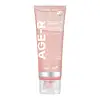What's inside
What's inside
 Key Ingredients
Key Ingredients

No key ingredients
 Benefits
Benefits

No benefits
 Concerns
Concerns

No concerns
 Ingredients Side-by-side
Ingredients Side-by-side

Water
Skin ConditioningMethylpropanediol
SolventGlycereth-26
HumectantGlycerin
HumectantNiacinamide
Smoothing1,2-Hexanediol
Skin ConditioningPolyglycerin-3
HumectantMethyl Gluceth-20
HumectantMethyl Gluceth-10
EmulsifyingCaprylic/Capric Triglyceride
MaskingAcrylates/C10-30 Alkyl Acrylate Crosspolymer
Emulsion StabilisingTromethamine
BufferingAllantoin
Skin ConditioningC12-14 Pareth-12
EmulsifyingSoluble Elastin
Skin ConditioningEthylhexylglycerin
Skin ConditioningParfum
MaskingAdenosine
Skin ConditioningSodium Hyaluronate
HumectantEclipta Prostrata Extract
Skin ConditioningButylene Glycol
HumectantMelia Azadirachta Leaf Extract
Skin ConditioningSoluble Collagen
HumectantMoringa Oleifera Seed Oil
EmollientPhosphatidylcholine
EmulsifyingHyaluronic Acid
HumectantSodium Hyaluronate Crosspolymer
HumectantHydrolyzed Sodium Hyaluronate
Skin ConditioningHydrolyzed Hyaluronic Acid
HumectantSodium Dna
Skin ConditioningAtelocollagen
Skin ConditioningDesamido Collagen
Skin ConditioningCeramide NP
Skin ConditioningPrunella Vulgaris Extract
AntioxidantFucus Vesiculosus Extract
EmollientHydrolyzed Collagen
EmollientSodium Acetylated Hyaluronate
HumectantHydroxypropyltrimonium Hyaluronate
Collagen
MoisturisingCollagen Amino Acids
MoisturisingGlycine
BufferingSerine
MaskingProcollagen
Skin ConditioningGlutamic Acid
HumectantLysine
Skin ConditioningAlanine
MaskingThreonine
Proline
Skin ConditioningArginine
MaskingWater, Methylpropanediol, Glycereth-26, Glycerin, Niacinamide, 1,2-Hexanediol, Polyglycerin-3, Methyl Gluceth-20, Methyl Gluceth-10, Caprylic/Capric Triglyceride, Acrylates/C10-30 Alkyl Acrylate Crosspolymer, Tromethamine, Allantoin, C12-14 Pareth-12, Soluble Elastin, Ethylhexylglycerin, Parfum, Adenosine, Sodium Hyaluronate, Eclipta Prostrata Extract, Butylene Glycol, Melia Azadirachta Leaf Extract, Soluble Collagen, Moringa Oleifera Seed Oil, Phosphatidylcholine, Hyaluronic Acid, Sodium Hyaluronate Crosspolymer, Hydrolyzed Sodium Hyaluronate, Hydrolyzed Hyaluronic Acid, Sodium Dna, Atelocollagen, Desamido Collagen, Ceramide NP, Prunella Vulgaris Extract, Fucus Vesiculosus Extract, Hydrolyzed Collagen, Sodium Acetylated Hyaluronate, Hydroxypropyltrimonium Hyaluronate, Collagen, Collagen Amino Acids, Glycine, Serine, Procollagen, Glutamic Acid, Lysine, Alanine, Threonine, Proline, Arginine